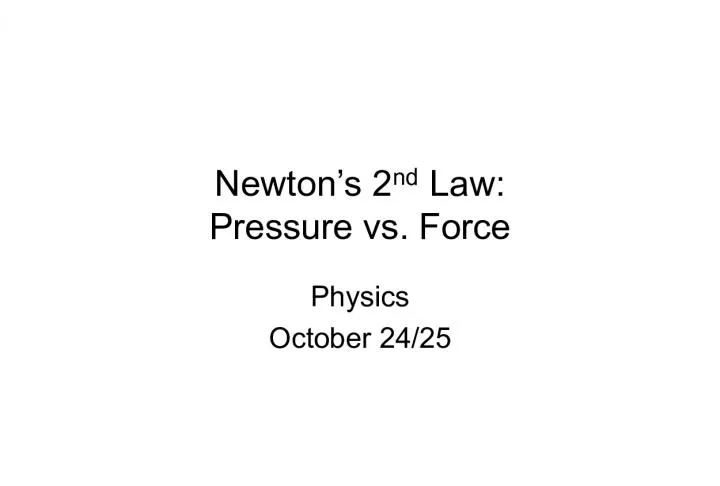Newton's 2nd Law: Pressure vs. Force Physics (October 24-25)


In this lesson, students will learn about the fundamental concept of pressure and how it relates to force. The objectives of the lesson are to
- Uploaded on | 11 Views
-
 polyan
polyan
About Newton's 2nd Law: Pressure vs. Force Physics (October 24-25)
PowerPoint presentation about 'Newton's 2nd Law: Pressure vs. Force Physics (October 24-25)'. This presentation describes the topic on In this lesson, students will learn about the fundamental concept of pressure and how it relates to force. The objectives of the lesson are to. The key topics included in this slideshow are . Download this presentation absolutely free.
Presentation Transcript
Slide1Newton’s 2nd Law: Pressure vs. Force Physics October 24/25
Slide2Objectives1. distinguish between force and pressure 2. Solve for pressure
Slide3What is pressure?Topic Pressure Facts • The amount of force per unit of area • When the force is perpendicular to the surface area, then: Pressure = force_______ Area of application
Slide4Pressure vs. ForcePressure • a push or pull (including weight) in a certain area • P = F/A • Units: Pa or N/m 2 Force • any push or pull (including weight) • F = ma • Units: N
Slide5What is pressure?Topic Pressure Facts Pressure = force_______ Area of application P = F A F = force (N) A = Area (m 2 ) P= Pressure (pascals- Pa) (N/m 2 )
Slide6More about pressureTopic What does the pressure equation tell us? P A Facts P = F/A • More area means less pressure • Less area means more pressure • Therefore, pressure and area are inversely proportional
Slide7Pressure vs. ForceTopic Why do the boxes have the same force? Facts • They have the same weight (weight is a force)
Slide8Pressure vs. ForceTopic Why do the boxes have different pressures? Facts • The standing book covers less area; therefore, has more pressure
Slide9Think CriticallyTopic What happens to force and pressure when you stand on scale with two feet vs. one foot? Facts force stays same b/c weight stays the same The pressure increases on one foot b/c same force (weight) applied to less area
Slide10Reach for the Stars- For EveryoneTopic If you are on thin ice, how should you get back to land without breaking the ice? Facts A. Tip-toe B. Crawl on all fours C. Lie down flat and push Answer: C
Slide11Reach for the StarsTopic Why should you lay down on thin ice? Facts When you lie flat, you increase your area which in turn decreases your pressure (P and A are inversely proportional). By decreasing the pressure it reduces the odds that the ice will crack.
Slide12Another Demo• Pressure vs. Force
Slide13Practice using the pressureequation Topic Michelle has a mass of 75 kg and sits at her desk with a pressure of 9000 Pa. What area does she cover on the chair? Facts Known m = 75kg P = 9000 Pa Unknown A Equation P=F/A Solve 1. w = (75kg)(10m/s 2 ) = 750N 2. P=F/A 9000 Pa = 750N A (9000 Pa)(A) = 750N (A) (A) (9000Pa)(A) = 750N (9000Pa) (9000 Pa) A = 0.083 m 2
Slide14Practice using the pressureequation Topic Brooke comes home from school and puts her books down on the kitchen table while she goes to grab a snack. The books have a combined weight of 25 N and the area of contact is 0.19 m by 0.24 m. What pressure do the books apply on the table? Facts Known F = 25N A = (0.19m)(0.24m) = 0.046m 2 Unknown P Equation P=F/A Solve P = (25N)/ (0.046m 2 ) = 543 Pa or 543 N/m 2
Slide15Class work• Practice solving for Pressure with handout
Slide16Closing• Why does the floor squeak when someone tip-toes on a wooden floor?
Slide17HomeworkPractice a study strategy to review notes so far on Newton’s laws 1. Write math problems from examples previously completed in class and solve them 2. For each topic, write a real world scenario for how the physics is present 3. Attend office hours, to check the accuracy of your answers and get clarification when needed 4. Take your notes, fold them in half and answer the questions without looking at the notes 5. Rewrite questions from class work and quizzes and answer them 6. Write tricks that can be confusing- come up with a song or slogan to distinguish subtly different concepts